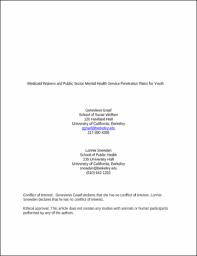
ATTENTION: The works hosted here are being migrated to a new repository that will consolidate resources, improve discoverability, and better show UTA's research impact on the global community. We will update authors as the migration progresses. Please see MavMatrix for more information.
Show simple item record
| dc.contributor.author | Graaf, Genevieve | |
| dc.contributor.author | Snowden, Lonnie | |
| dc.date.accessioned | 2019-07-08T17:49:02Z | |
| dc.date.available | 2019-07-08T17:49:02Z | |
| dc.date.issued | 2018 | |
| dc.identifier.citation | Graaf, G.,& Snowden, L. (2018). Medicaid waivers and public sector mental health service penetration rates for youth. The American Journal of Orthopsychiatry.88(5), 597-607. | en_US |
| dc.identifier.issn | 0002-9432 | |
| dc.identifier.uri | http://hdl.handle.net/10106/28287 | |
| dc.description | ©American Psychological Association, 2018. This paper is not the copy of record and may not exactly replicate the authoritative document published in the APA journal. Please do not copy or cite without author's permission. The final article is available, upon publication, at: 10.1037/ort0000295 | en_US |
| dc.description.abstract | **Please note that the full text is embargoed** ABSTRACT: Background: To assist families of youth with serious emotional disturbance in financing youth’s comprehensive care, some states have sought and received Medicaid waivers. Medicaid waivers, waive or relax the Medicaid means test for eligibility to provide insurance coverage to non-poor families for expensive, otherwise out-of-reach treatment for youth with Serious Emotional Disturbance (SED).
Aims of the Study: Waivers promote treatment access for the most troubled youth, and the present study investigated whether any of several Medicaid waiver options—and those that completely omit the means test in particular—are associated with higher state-wide public sector treatment penetration rates.
Methods: The investigators obtained data from the U.S. Census, SAMHSA’s Uniform Reporting System, and the Centers for Medicare and Medicaid Services. Analysis employed random intercept and random slope linear regression models, controlling for a variety of state demographic and fiscal variables, to determine if a relationship between Medicaid waiver policies and statelevel public sector penetration rates could be observed.
Results: Findings indicate that, whether relaxing or completely waiving Medicaid’s qualifying income limits, waivers increase public sector penetration rates, particularly for youth under age 17. However, completely waiving Medicaid income limits did not uniquely contribute to penetration rate increases.
Conclusions and Implications: States offering Medicaid waivers that either relax or completely waive Medicaid’s means test to qualify for health coverage present higher public sector treatment rates for youth with behavioral healthcare needs. There is no evidence that restricting the program to waiving the means test for accessing Medicaid would increase treatment access. | en_US |
| dc.language.iso | en_US | en_US |
| dc.publisher | American Psychological Association | en_US |
| dc.relation.ispartofseries | The American Journal of Orthopsychiatry; | |
| dc.title | Medicaid Waivers and Public Sector Mental Health Service Penetration Rates for Youth | en_US |
| dc.type | Article | en_US |
Files in this item
- Name:
- Graaf&Snowden,JOrtho.pdf
- Size:
- 574.2Kb
- Format:
- PDF
- Description:
- PDF
This item appears in the following Collection(s)
Show simple item record


